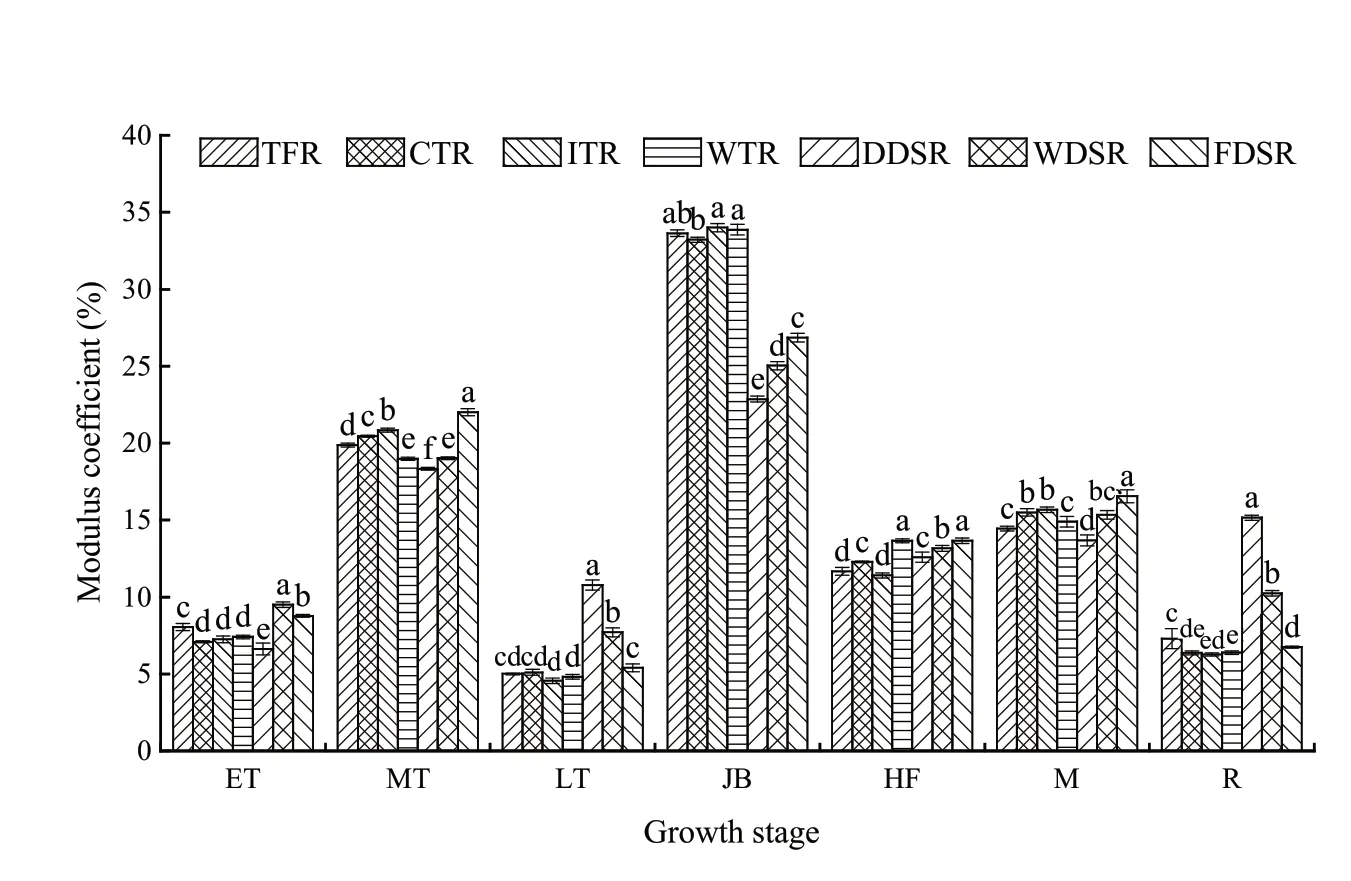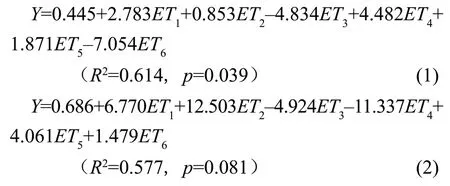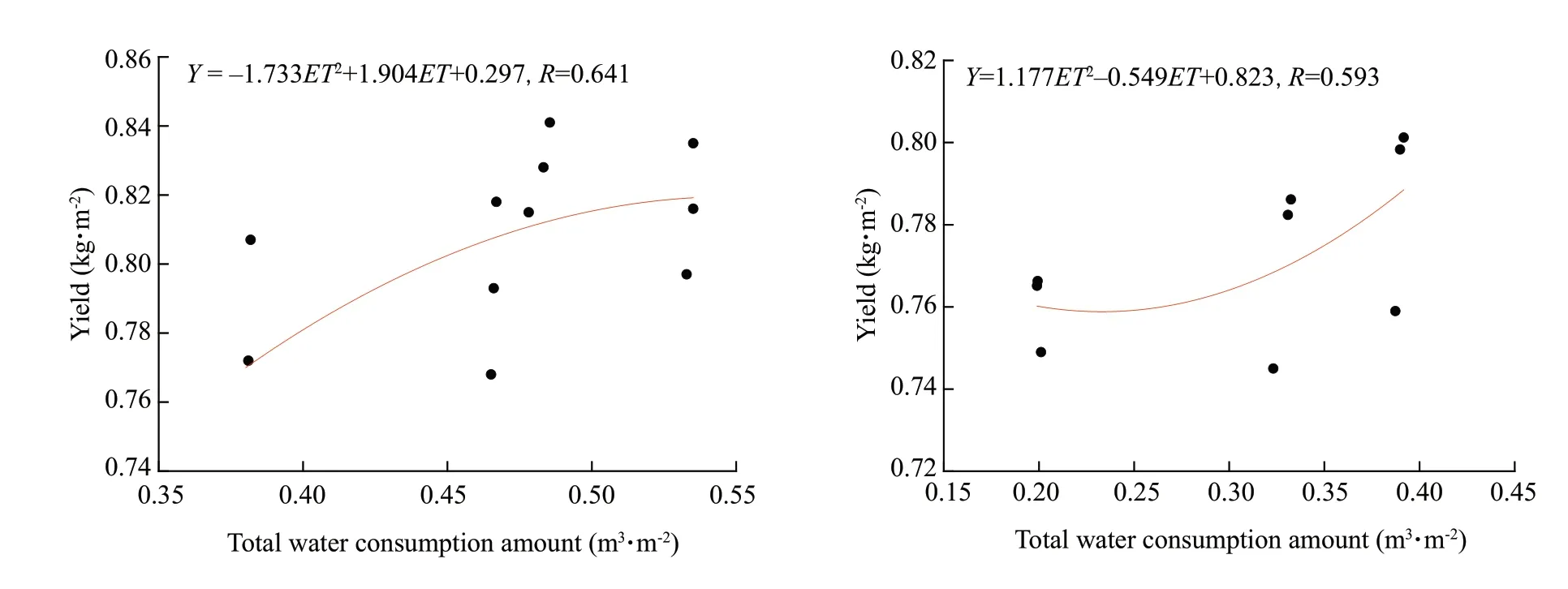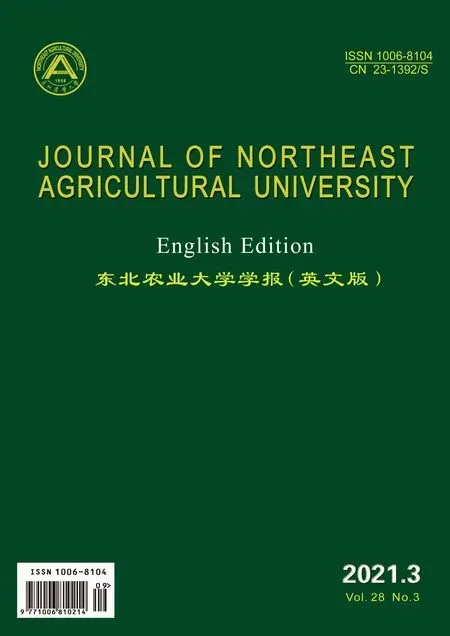Water Consumption Processes of Different Planting Models in Rice Production of Northeast China
Ji Jun-chao, Wei Yong-xia, , Liu Hui , and Ahmad Khan
1 School of Water Conservancy and Civil Engineering, Northeast Agricultural University, Harbin 150030, China
2 Key Laboratory of Effective Utilization of Agricultural Water Resources, Ministry of Agriculture and Rural Affairs, Harbin 150030, China
3 School of Arts and Science, Northeast Agricultural University, Harbin 150030, China
Abstract: Different irrigation schemes have different effects on water consumption in rice production.However, few studies have been conducted on the water consumption processes between dry direct seeding rice and transplanting rice under different irrigation schemes.Water consumption process, water use efficiency and correlation effect of water consumption on yield under different planting models in rice production were investigated in northeast China in 2018.Seven treatments were implemented: drip irrigation dry direct seeding rice (DDSR), wet irrigation dry direct seeding rice (WDSR), flooded irrigation dry direct seeding rice (FDSR), transplanting flooded rice (TFR), controlled irrigation transplanting rice (CTR), intermittent irrigation transplanting rice (ITR) and wet irrigation transplanting rice (WTR).Among them, TFR was the control.The results showed that the peaks of the water consumption amount, intensity and its modulus coefficient of the seven treatments all appeared in the middle tillering and the jointing booting stages.The total water consumption amount (ET) and average water consumption intensity of DDSR, WDSR, FDSR and WTR were lower than those of TFR, CTR and ITR.The maximum water use efficiency of yield (WUEy) occurred in DDSR with a value of 3.8 kg • m-3.WUEy of DDSR, WDSR and FDSR were significantly higher than those of TFR, CTR and ITR.In the middle tillering and the heading and flowering stages, the water consumption amount of each treatment had a positive effect on yield formation, and the water consumption amount in the late tillering stage had a negative effect on yield formation.The relationship between ET and yield (Y) of dry direct seeding and transplanting planting models showed a quadratic function curve.ET of transplanting planting model had a significant positive impact on Y, and ET of dry direct seeding planting model had no impact on Y.DDSR had the least total water consumption of 199.8 mm • m-2, the lowest water consumption intensity of 2.0 mm • d-1 and the greatest water use efficiency of 3.8 kg • m-3, which suggested that DDSR had the most significant water saving effect.The combination of dry direct seeding planting model and drip irrigation scheme would be a good option for determining a water-saving rice planting model in northeast China.
Key words: rice, dry direct seeding, water consumption, water use efficiency, planting model
Introduction
Rice (Oryza sativaL.) is one of the most important food crops in China.The sown area of rice accounts for 26% of the total area of food crops in China.The rice planting area in northeast China accounts for 17% of the total rice planting area in China, and the water consumption of rice accounts for more than 70% of the total regional agricultural water consumption (Wanget al., 2018).Rice production in northeast China is primarily in the form of transplanting which has problems of excessive water consumption and low irrigation water utilization efficiency with effective utilization coefficient of 0.548.It is essential to carry out research on the efficient water-saving planting model of rice in northeast China, which is of great significance for the efficient utilization of agricultural water resources, and thus alleviating the pressure of water resources (Weiet al., 2018).
Traditional transplanting flooded rice has the characteristics of greater water consumption and low water use efficiency.Nowadays rice is changing from traditional flooded irrigation to water-saving irrigation.After the in-depth investigation on water-saving irrigation technology for rice by researchers, several water-saving irrigation models such as controlled irrigation, intermittent irrigation and wet-shallow irrigation have been developed (Yang and Wang, 2018).The effects of wet irrigation and intermittent irrigation on water saving and increasing yield are better than traditional flood irrigation (Nieet al., 2011).The intermittent irrigation has better water saving effect than continuous flooded rice, and does not reduce rice yield (Avilaet al., 2015).Compared with traditional transplanting rice, dry direct seeding rice saves the steps of steeping fields, seedling raising and transplanting, which has the advantages of water saving, cost saving, and has been widely applied in the world (Xuet al., 2018; Panet al., 2017; Xuet al., 2013).For instance, the water consumption amount of direct seeding upland rice is 1/5-1/3 than that of paddy rice, and the irrigating water amount is 1/5 or less (Zhao, 2004).The direct seeding rice saves 2 415 Yuan per hectare in production cost compared with transplanting rice (Zhanget al.,2020).The dry direct seeding rice greatly reduces the input of irrigation water, and greatly improves water production efficiency and water and nitrogen use efficiency compared with transplanting flooded rice (Liu, 2017).
Many researches have investigated the water consumption processes of rice in northeast China.However, few studies compared the water consumption processes between dry direct seeding rice and transplanting rice under different irrigation schemes.The changes of water consumption, water consumption intensity, water consumption modulus coefficient and correlation effect of water consumption under different rice planting models in the black soil region of northeast China were investigated.The findings could provide a theoretical basis for the exploration of rice planting model with high efficient water-saving in northeast China.
Materials and Methods
Plant materials
The rice variety Longqiangdao-3 was chosen for this study.
Experimental site
The experiment was conducted from May to September 2018 at Key Experiment Station of Qingan National Irrigation, Heilongjiang Province, China (46°52′41″N, 127°30′04″E).The study area is located in cold temperate continental monsoon zone, with annual temperature of 2.5℃, precipitation of 550 mm and frostfree period of 128 days.The soil is a typical Mollisols classified as albic rice soil and the basic soil properties are as the followings: organic matter of 41.8 g • kg-1, the total nitrogen, phosphorus, and potassium are 15.06, 15.23 and 20.11 g • kg-1, respectively and available nitrogen, phosphorus and potassium of 198.29,36.22 and 112.06 mg • kg-1, pH 6.45, bulk density of 1.01 g • cm-3and saturated water content of 50%.
Experimental design
The experiment was carried out in bottomed pits with movable canopy.Seven treatments were implemented: drip irrigation dry direct seeding rice (DDSR), wet irrigation dry direct seeding rice (WDSR), flooded irrigation dry direct seeding rice (FDSR), transplanting flooded rice (TFR), controlled irrigation transplanting rice (CTR), intermittent irrigation transplanting rice (ITR) and wet irrigation transplanting rice (WTR).Among them, TFR was the control.Each treatment had three replicates, and 21 pits in total with each pit area of 2 m×2 m.For the treatment of dry direct seeding rice, 10-12 seeds were directly sown in each drill (spacing 10 cm) manually with row spacing of 10 cm + 26 cm + 10 cm, and the sowing date was May 1st, 2018.Three drip irrigation belts were laid in each pit of DDSR with the drip spacing of 30 cm and drip discharge of 1.2 L • h-1.For the treatment of transplanting rice, rice seedlings were transplanted manually, the drill and row spacing was designed as 13 and 30 cm, respectively and the transplanting date was May 18th, 2018.The irrigation schemes of transplanting and dry direct seeding rice are shown in Tables 1 and 2.Urea (N, 46%) was used as nitrogen fertilizer at 110 kg • hm-2.N was applied at a ratio of 4.5 : 2 : 1.5 : 2 at the pre-sowing or pretransplanting, early tillering, panicle initiation and booting stages.Phosphorus (P, 45 kg P2O5• hm-2) was applied to soil as base fertilizer at one time.Potassium chloride (K, 60%) was used as potash fertilizer at 80 kg • hm-2.K applied at a ratio of 1:1 at the pre-sowing or pre-transplanting and panicle initiation stages.The rice was harvested on September 20, 2018.

Table 1 Irrigation schemes for transplanting rice

Table 2 Irrigation schemes for dry direct seeding rice
Measurement of soil water content
For treatments or stages that did not contain a water layer, four sampling points were taken from each measuring pit, and soil samples were collected at the depth of 10, 20, 40 and 60 cm for each sampling point.The soil moisture content was measured by oven drying method.For treatments or stages, water layer was established, and water gauge was used to directly measure the depth change of water layer.
Measurement of irrigation water amount
When the soil water content reached the lowest limit of soil moisture content, and the upper limit of soil moisture content was then adjusted manually.The irrigation water amount was measured by accurate water meter, and date of irrigation and water meter reading were recorded at the same time.The water consumption amount of rice at different growth stages was calculated according to the principle of water balance.The experiment was carried out in bottomed pits with movable canopy, which could ignore the rainfall and paddy field seepage.The calculation formula was as following:

Where,ETiwas the water consumption amount, during the calculation interval;Iwas the irrigation water amount per unit area, during the calculation interval (mm); ΔWwas the change of soil moisture content, during the calculation interval (mm).
Measurement of yield
Rice yield was estimated by harvesting the plants per unit area manually for each pit.The panicle number, grain number per spike, setting percentage and thousand kernel weight of each treatment were calculated, based on six random hills of rice.
Measurement of water use efficiency
The water use efficiency of yield was calculated, according to yield and irrigation water amount.The calculation formula was as the following:

Where,WUEywas water use efficiency of yield;Ywas rice yield (kg • hm-2);ETwas the irrigation water amount, during the whole growth period (m3• hm-2).
Data analysis
The data statistical analysis was performed using SPSS software version 20.0 (SPSS Inc., USA).Means were tested by the least significant difference atp<0.05 (LSD0.05).Origin software version 9.0 (OriginLab Inc., USA) was used to perform graphing.
Results
Changes of water consumption amount at different growth stages
The changes of water consumption amount (WA) in the seven treatments at different growth stages were similar (Fig.1).WA of TFR at each growth stage reached the maximum, and WA of DDSR at each growth stage reached the lowest (except for LT and the yellow ripe stage (R)).WA of the seven treatments reached the maximum in JB, WA of CTR, ITR, WTR, DDSR, WDSR and FDSR were significantly reduced by 13.9%, 8.8%, 28.2%, 74.6%, 54.2% and 41.8%, respectively compared with TFR (p<0.05).WA of CTR, ITR, WTR, WDSR and FDSR reached the minimum in LT, WA of CTR, ITR, WTR, WDSR and FDSR were significantly reduced by 11.6%, 18.2%, 31.8%, 5.7% and 21.7%, respectively compared with TFR (p<0.05).In the treatment of transplanting rice, the total WA of TFR was 534.4 mm • m-2, and the total WA of CTR, ITR and WTR were significantly reduced by 12.8%, 9.7% and 28.7%, respectively compared with TFR (p<0.05).In the treatment of dry direct seeding rice, the total WA of DDSR, WDSR and FDSR were significantly reduced by 62.6%, 38.4% and 27.1%, respectively compared with TFR (p<0.05).These showed that dry direct seeding rice and wet irrigation transplanting rice could significantly save irrigation water, especially DDSR with integrated water and fertilizer technology had the best water saving effect.

Fig.1 Changes of water consumption amount
Changes of water consumption intensity at different growth stages
The water consumption intensity (WCI) was WA in unit time of plants per unit area.The changing process of WCI in the seven treatments all showed M shape, and each treatment reached the first peak in MT.In the treatment of transplanting rice, WCI of TFR was 5.9 mm • d-1, and WCI of CTR, ITR and WTR was significantly reduced by 10.3%, 5.4% and 31.9%, respectively compared with TFR (p<0.05).For treatment of dry direct seeding rice in MT, WCI of DDSR was the smallest with 2.0 mm • d-1, and WCI of DDSR, WDSR and FDSR was significantly reduced by 65.5%, 41.1% and 19.2%, respectively compared with TFR (p<0.05).In JB, WCI of each treatment was higher, during the whole growth period, and the peaks of DDSR and WDSR were significantly reduced compared with TFR, CTR and ITR.In JB, WCI of DDSR, WDSR, FDSR, CTR, ITR and WTR was significantly reduced by 69.8%, 45.6%, 30.9%, 13.9%, 8.8% and 28.2%, respectively compared with TFR (p<0.05), indicating that the water saving effect of dry direct seeding rice was remarkable.From HF to R, WCI of each treatment decreased gradually.The average WCI from large to small was in the order of TFR, ITR, CTR, FDSR, WTR, WDSR and DDSR, and the differences were significant (p<0.05).

Fig.2 Changes of water consumption intensity
Changes of water consumption modulus coefficient at different growth stages
The water consumption modulus coefficient (WMC) of crop referred to the ratio of WA during some growth stages to the total WA during the whole growth period, which reflected not only the characteristics of water consumption at each growth stage of crops, but also the sensitivity of crops to water at different growth stages and the importance of irrigation (Penget al., 2014).The changing process of WMC of the seven treatments was consistent with the changing process of WA.In MT for the first peak, DDSR, WDSR and WTR significantly reduced WMC by 7.8%, 4.3% and 4.5%, respectively (p<0.05), while FDSR, CTR and ITR significantly increased WMC by 10.8%, 2.9% and 4.9%, respectively compared with TFR (p<0.05).This indicated that FDSR, CTR and ITR had higher water requirement than TFR, during the period of fast tillering.WMC of each treatment reached the maximum in JB.For the treatment of transplanting rice, CTR, ITR and WTR increased WMC by 1.3%, 1.1% and 0.7%, respectively compared with TFR.However, for the treatment of dry direct seeding rice in JB, DDSR, WDSR and FDSR significantly reduced WMC by 32.0%, 25.6% and 20.2%, respectively compared with TFR (p<0.05).This demonstrated that JB was the water sensitive stage, and the water consumption and utilization amount of rice were greater, while the water sensitivity of dry direct seeding rice was lower than that of transplanting rice.In HF, compared with TFR, ITR decreased WMC by 2.2%, and the other treatments significantly increased WMC.In M, compared with TFR, DDSR decreased WMC by 5.3%, while the other treatments also increased WMC.

Fig.3 Changes of water consumption modulus coefficient among different treatments
Water use efficiency
WUEywas a comprehensive index that measured the relationship between water consumption and crop yield (Nieet al., 2011; Sadras and Rodriguez, 2007).The higher the water use efficiency, the stronger the water-saving capacity of the plants.The maximumWUEyoccurred in DDSR with a value of 3.8 kg • m-3, while the minimumWUEyoccurred in TFR with a value of 1.5 kg • m-3.WUEyof WDSR, FDSR, CTR, ITR and WTR was significantly increased by 53.6%, 32.1%, 11.4%, 12.5% and 32.7%, respectively compared with TFR (p<0.05).This demonstrated that dry direct seeding planting model was beneficial to improveWUEy, especially DDSR with integrated water and fertilizer technology.DDSR, WDSR and FDSR could reduce the evaporation of field water and the moisture loss of water in plants.Thus, the water use efficiency was significantly improved.The wet irrigation could also achieve a certain degree of water saving effect as found in present study.
Relationship between water consumption amount at different growth stages and yield
The water consumption of rice was a continuous and dynamic process.The water consumption amount at each growth stage influenced not only the accumulation of dry matter, but also the final yield (Wuet al., 2018).Fitting equations of water consumption amount at each growth stage were established (ET1-ET6representing, respectively, the water consumption amount in ET, MT, LT, JB, HF and M) and yield for different planting models was as the followings:

The fitting effect of the two equations was relatively ideal.Equation (1) was the fitting of transplanting planting model, which passed the significance test.Equation (2) was the fitting of dry direct seeding planting model, which failed the significance test.In equation (1),ET1andET3failed the significance test (p1=0.074 andp2=0.148).These indicated that the water consumption of transplanting rice had no significant effect on yield inETandLT.In equation (2), the coefficients ofET3andET4were negative, indicating the water consumption amount of dry direct seeding rice in LT and JB had a negative effect on yield formation.In equation (3), the coefficients ofET3andET6were negative, which also indicated that the water consumption amount of transplanting rice in LT and M had a negative effect on yield formation.
Relationship between the total water consumption amount and yield
The correlation coefficients of the two equations were 0.641 and 0.593, respectively, which demonstrated that fitting results of the equations were representative.The relationship betweenETandYof different planting models was quadratic function curve.Within a certain degree,Yincreased with the increase ofET.The fitting equation of transplanting planting model wasY=–1.733ET2+1.904ET+0.297 (p=0.032), which indicated thatETof transplanting rice had a significant and positive effect onY.The fitting equation of dry direct seeding planting model wasY=1.177ET2–0.549ET+0.823 (p=0.055), which also indicated thatETof dry direct seeding rice had a positive effect onY.The range ofETfor dry direct seeding and transplanting rice was 0.20-0.39 m3• m-2and 0.38-0.54 m3• m-2, respectively, and the value range was limited.IfETcontinued to increase, the curve might not appear the same trend.Therefore, the relationship betweenYandETshould be coordinated to achieve the goal of water saving and high yield.

Fig.4 Fitting of ET and Y
Discussion
Traditional flooded rice theory was based on sufficient irrigation.The irrigation method not only caused a large amount of soil evaporation and deep percolation, but also increased crop transpiration (Deng, 2006).This study found that DDSR with integrated water and fertilizer technology had high irrigation uniformity, soil reaching the upper limit of irrigation quickly, and the rice could absorb sufficient water at the same time, which lowered WA and the water saving effect more significantly.The findings of the maximum values of water consumption amount, intensity and its modulus coefficients of different planting models all appeared in JB, and "M" shape for the changing process of WCI was consistent with the result of Chenget al(2006).Therefore, JB was the critical stage for water requirement of rice, and ensuring sufficient water supply in this stage could achieve high yield.The significant reduction of the total water consumption amount by dry direct seeding rice relative to traditional transplanting rice demonstrated in present study supported the results of Taoet al(2015).The study was carried out in bottomed pits equipped with a rain shelter.Although the influence of rainfall and leakage was isolated, it was different from the field growth environment, and further research is needed to integrate with specific environmental conditions.
WUEyreflected the level of economical use of water, and was an important reference basis for determining the input and output of irrigation water and water saving (Ji, 2008).The study found that compared with transplanting planting model, dry direct seeding planting model significantly improvedWUEy.The yields of DDSR, WDSR and FDSR were lower than those of TFR, CTR and ITR, which was due to the significant reduction of WA.Compared with conventional flooded rice, the controlled irrigation, intermittent irrigation and wet irrigation transplanting rice improved water use efficiency.The reasons might be due to the coordination between source accumulation and sink formation, which made the yield structure more reasonable (Chenget al., 2006), and thus improved water use efficiency.Therefore, moderately promoting dry direct seeding planting technology was of great significance for reducing agricultural irrigation water and developing sustainable agriculture.
Increasing soil water moisture during the early stage of rice growth was considered as the key factor that led to high water use efficiency (Lianget al., 2019).However, it could be found that dry direct seeding treatment with lower soil moisture had higher water use efficiency.The reason might be that dry direct seeding rice experienced drought resistance exercise at the seedling stage, which could enhance its drought adaptability.Similarly the transplanting rice with part or no water layer could improve its drought adaptability and make water use efficiency reaching a higher level.The study found that the water consumption amount in HF, M, ET and MT had no significant and positive effects on yield, while the water consumption amount in LT and JB had a negative effect on yield formation, which confirmed the result of Liuet al(2020).
Conclusions
The peaks of water consumption amount, intensity and its modulus coefficient of different planting models all appeared in MT and JB.Compared with transplanting planting model, the dry direct seeding planting model significantly reduced the total water consumption amount and average water consumption intensity, and improvedWUEy.DDSR had the most significant water saving effect, and itsWUEyreached the maximum of 3.80 kg • m-3.CTR and WTR also had a certain degree of water saving effect.WA of dry direct seeding and transplanting planting models in MT and HF had a positive effect on yield formation, while WA in LT had a negative effect on yield formation.The relationship betweenETandYof dry direct seeding and transplanting planting models showed a quadratic function curve.ETof transplanting planting model had a significant and positive impact on yield, andETof dry direct seeding planting model had no impact on yield.
 Journal of Northeast Agricultural University(English Edition)2021年3期
Journal of Northeast Agricultural University(English Edition)2021年3期
- Journal of Northeast Agricultural University(English Edition)的其它文章
- Optimum Combination Test of Erosion Gully in Black Soil Regions by Coal Gangue Reconstruction Soil
- Effect of Chilling Stress on Synthesis of Antioxidant Enzymes, Osmotic Adjustment Substances and Membrane Lipid Peroxide Levels in Two White Clover Cultivars
- Complete Genome Sequencing and Analysis of Rehmannia Mosaic Virus Isolate from Shanxi Province
- Reversal Effects of Ivermectin and Moxidectin on Multidrug Resistance in C6/adr Cells in vitro
- Effects of DHRS3 in C2C12 Myoblast Differentiation and Mouse Skeletal Muscle Injury
- Effects of Lanthanum and Cerium on Seeds Fatty Acid Composition in Soybean
